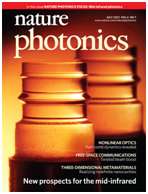Tiny crystalline resonators produce mid-infrared frequency combs for fingerprinting of molecules

Most molecules, including those of importance in medical diagnostics or pollution monitoring, have characteristic "fingerprints" in the mid-infrared spectral region. However, state-of-the-art mid-infrared frequency comb techniques require systems that are often costly and limited in their applications. In an article just published in Nature Communications (January 8th, 2013), scientists of the Laser Spectroscopy Division of the Max-Plank-Institute of Quantum Optics, in a collaboration with the Ecole Polytechnique de Lausanne (Switzerland), the Ludwig-Maximilians-Universität Munich, the Menlo Systems GmbH and the Institut des Sciences Moléculaires d'Orsay (France), have demonstrated the generation of mid-infrared frequency combs with small crystalline micro-resonators. Such miniaturized instruments, which can detect and characterize such molecules quickly and with high sensitivity, could revolutionize many areas of science and technology.
Optical frequency comb generators are coherent light sources, which produce a "comb" of many precisely evenly spaced spectral lines. During the last decade, such combs have revolutionized the art of measuring the frequency of light, as recognized in 2005 by the award of the Physics Nobel Prize to Prof. Theodor W. Hänsch. Today frequency combs are becoming enabling tools for new and unexpected applications. In particular, frequency combs are strongly impacting molecular spectroscopy by dramatically improving the recording speed, the resolution and the accuracy of Fourier spectrometers. The mid-infrared spectral range, also called molecular fingerprint region, is of primary importance to molecular physics. However, as reviewed in an article published in the July 2012 issue of Nature Photonics, emerging mid-infrared frequency comb techniques still need considerable improvements: the systems are often based on nonlinear frequency conversion of near-infrared laser sources, which makes them bulky, and their use is limited to specialists.
The new technique developed by a team of scientists at MPQ avoids these obstacles. Here, mid-infrared frequency comb radiation is generated by exciting whispering gallery modes in a small toroidal monolithic resonator. A crystalline micro-resonator with a quality-factor exceeding 109 is pumped by a continuous-wave laser. By a nonlinear process called four-wave mixing, it produces a broad comb spectrum consisting of discrete lines spaced by 100 GHz at mid-infrared wavelengths near 2.5 µm. "The remarkable characteristics of such comb generators are their small size, large line-spacing, high power per comb line, and efficient conversion," says Dr. Christine Wang, the post-doc who has performed the experiment. "An appropriate choice of the material – here magnesium fluoride – and proper engineering are crucial to realize broad spectral span and low-phase noise, as required for frequency comb operation." Such miniaturized sources hold much promise for on-chip frequency-comb spectrometers. The spectrum of the fundamental vibrations of liquid phase samples might be measured within a few nanoseconds with a similar refresh time!
More information: Wang, C. et al. Mid-infrared optical frequency combs at 2.5 μm based on crystalline microresonators, Nature Communications 4, Article number: 1345, Issue of January 8th, 2013, DOI: 10.1038/ncomms2335
Journal information: Nature Communications , Nature Photonics
Provided by Max Planck Society



















